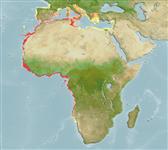Classification / Names
Common names from other countries
Main reference
Size / Weight / Age
Max length : 30.0 cm SL male/unsexed; (Ref. 188); common length : 25.0 cm SL male/unsexed; (Ref. 188); max. published weight: 927.00 g (Ref. 3808)
Length at first maturity
Lm 13.4, range 11 - 19.5 cm
Environment
Marine; brackish; pelagic-neritic; oceanodromous (Ref. 51243); depth range 0 - 80 m (Ref. 27000)
Climate / Range
Subtropical; 24°C - ? (Ref. 54872), preferred 24°C (Ref. 107945); 46°N - 23°S, 17°W - 36°E (Ref. 54872)
Distribution
Atlantic Ocean: eastern Atlantic Ocean from Gibraltar southward to Angola, with a single specimen reported from Walvis Bay, Namibia (Ref. 188, 81269). Also known from Mediterranean Sea in the southern and eastern parts, penetrating also the Suez Canal (Ref. 188).
Countries | FAO areas | Ecosystems | Occurrences | Introductions
Short description
Dorsal
spines
(total): 0;
Dorsal
soft rays
(total): 18-21;
Anal
spines: 0;
Anal
soft rays: 17 - 23. Diagnosis: Body elongate, but variable in depth, belly fairly sharply keeled; total scutes 31-34 (Ref. 188, 81269). Lower gillrakers 70-166 (Ref. 188, 81269). Upper pectoral fin rays white on outer side, the membrane between black (Ref. 188). Sardinella maderensis resembles S. aurita, but pelvic fin with 1 unbranched and 7 branched rays and no black spot on hind part of gill cover, but a faint gold or black area just behind gill opening (Ref. 188). It is distinguished from S. rouxi by having more lower gillrakers, only 30-40 in S. rouxi, and the caudal fin grey, its tips almost black vs. yellow in S. rouxi (Ref. 188).
IUCN Red List Status (Ref. 115185)
Threat to humans
Harmless
Human uses
Fisheries: highly commercial; bait: usually
More information
ReferencesAquacultureAquaculture profileStrainsGeneticsAllele frequenciesHeritabilityDiseasesProcessingMass conversion
Tools
Special reports
Download XML
Internet sources
Estimates of some properties based on models
Phylogenetic diversity index
PD50 = 0.5000 many relatives (e.g. carps) 0.5 - 2.0 few relatives (e.g. lungfishes)
Trophic Level
3.2 ±0.38 se; Based on food items.
Resilience
Medium, minimum population doubling time 1.4 - 4.4 years (K=0.34; tm=3; tmax=6)
Vulnerability
Low to moderate vulnerability (33 of 100)
Price category
